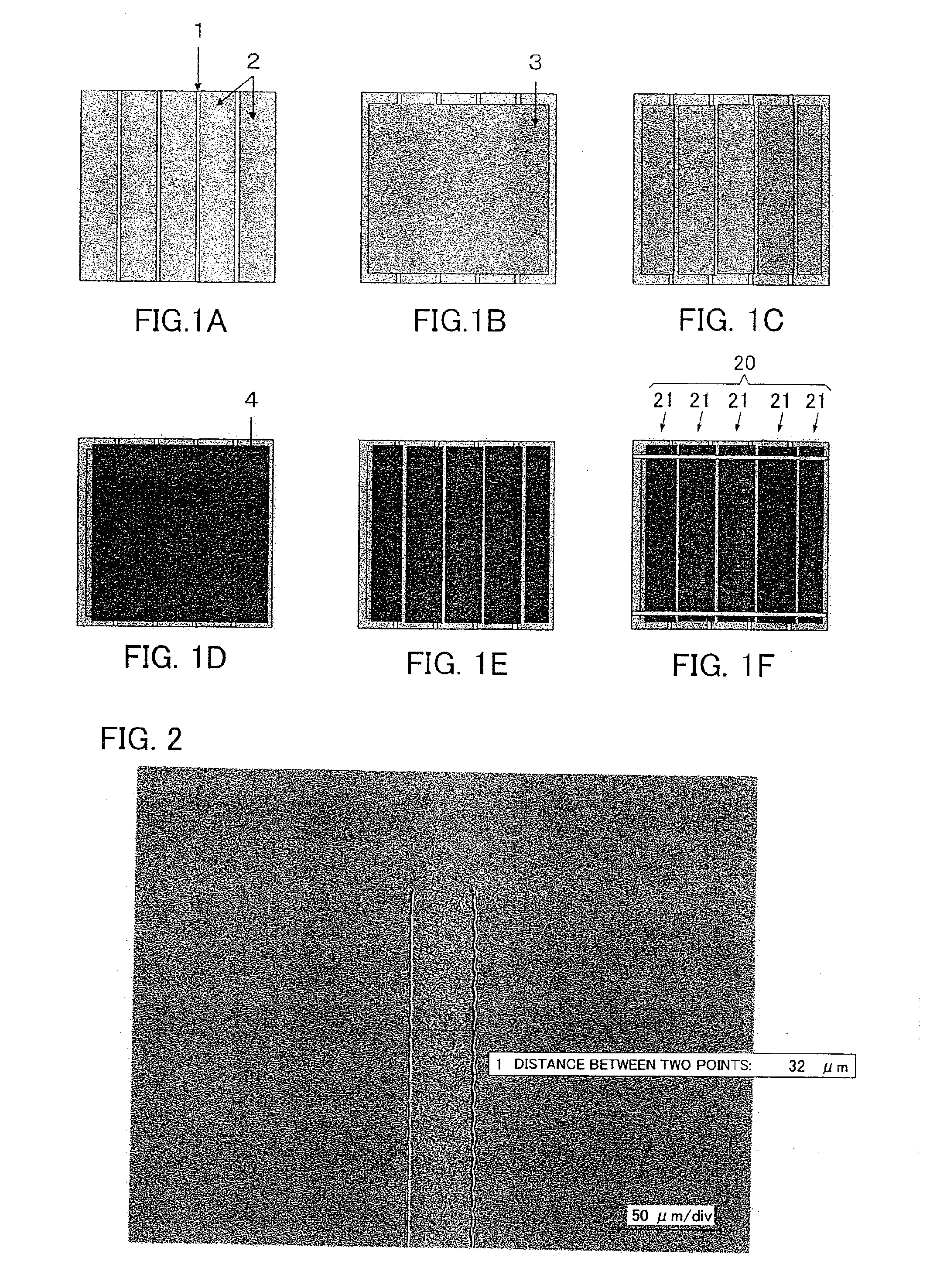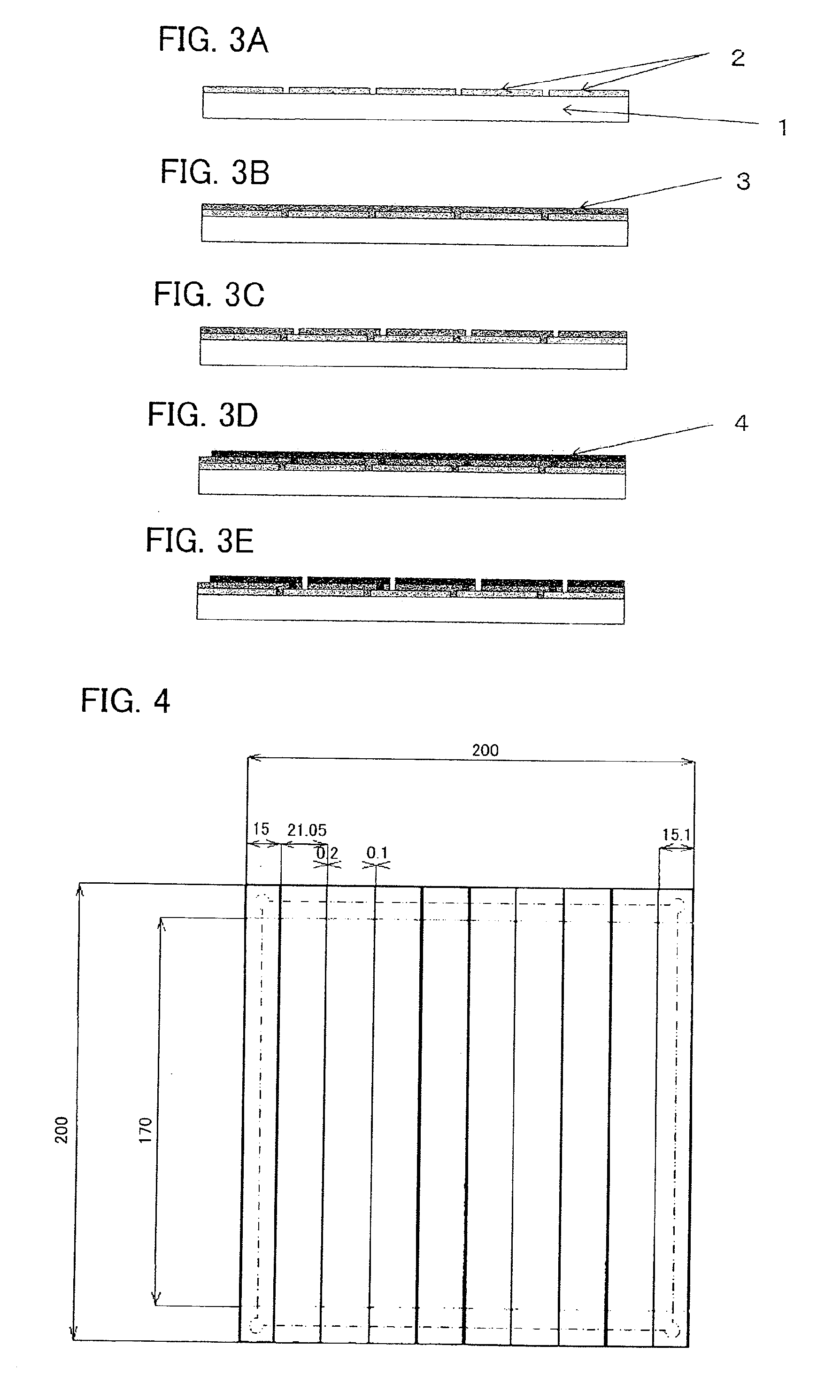Integrated organic light-emitting device, method for producing organic light-emitting device and organic light-emitting device produced by the method
a technology of organic light and light, which is applied in the manufacture of electric discharge tubes/lamps, tube/lamp factory adjustment, discharge tubes luminescnet screens, etc., can solve the problems of reducing luminance efficiency and expanded brightness distribution, accelerating deterioration of organic thin films, and affecting the quality of organic light, so as to inhibit the expansion of brightness distribution and heat generated in power distribution, the effect of high resistan
- Summary
- Abstract
- Description
- Claims
- Application Information
AI Technical Summary
Benefits of technology
Problems solved by technology
Method used
Image
Examples
example 1
[0201]The light-transmissive substrate employed an alkali-free glass having a thickness of 0.7 mm and coated with an indium-doped tin oxide (ITO) film of 150 nm average film thickness on the entire surface. The substrate (200 mm×200 mm) was placed on an XY stage with the ITO film facing upward. A laser beam was applied from above using a light source of a fundamental harmonic of a YAG laser, so as to remove a part of the ITO film as shown in FIG. 1A while minimizing the possibility of damaging the glass. This step formed the first-electrode-layer dividing grooves 110 on the conductive electrode layer 102 by executing the first laser scribing step. The laser beam had an oscillation frequency of 15 kHz, an output power of 14 W, a beam diameter of about 25 μm, and a processing speed of 50 mm / second. FIG. 2 shows an enlarged planar photo of a laser-processed portion of the glass substrate with the patterned ITO film.
[0202]The resulting substrate was washed with a neutral detergent and h...
example 2
[0215]The substrate employed an alkali-free glass (200 mm×200 mm) having a thickness of 0.7 mm and coated with an ITO film of 150 nm average film thickness. The ITO film had undergone chemical etching into a form shown in FIG. 1A, and had an average etching width of 50 μm. The resulting substrate was washed with a neutral detergent and heated at 150 degrees centigrade for 20 minutes so as to be dried. It was confirmed that resistance values between strip-like ITO portions each were in general 20 MΩ or more. Thereafter, the resulting substrate was placed in a vacuum evaporator, as a result an organic EL device was produced in the same method as in Example 1. The performance of the integrated organic EL device produced in this method was measured in the same manner as Example 1. Average brightnesses of the same portions as those of Example 1 are shown in Table 1.
[0216]This Example executed a chemical etching on the light-transmissive conductive layer for the patterning in Example 1. D...
example 3
[0217]An integrated organic EL device was produced by the same method as in Example 1. Two adjacent strip-like pieces were chosen from the second electrode layer of the device so as to be subjected to the following procedure. A voltage of 0.1 V was applied in between the pieces in a direction opposite to the elements and resistances therebetween were measured. The results are shown by white circles (o) on the far left in FIG. 9. Thereafter, the applied voltage was increased repeatedly by 0.1 V and the resistances were measured each time until the voltage reached 5 V. The results are shown by white circles (o) other than those on the far left in FIG. 9. Then, after the applied voltage was decreased to 0 V, the voltages were increased repeatedly by 0.1 V and the resistances were measured until reaching 5 V. The results are shown by black circles () in FIG. 9. The results support that application of a voltage above a certain level eliminates micro defects and reduces leakage current. ...
PUM
 Login to View More
Login to View More Abstract
Description
Claims
Application Information
 Login to View More
Login to View More - R&D
- Intellectual Property
- Life Sciences
- Materials
- Tech Scout
- Unparalleled Data Quality
- Higher Quality Content
- 60% Fewer Hallucinations
Browse by: Latest US Patents, China's latest patents, Technical Efficacy Thesaurus, Application Domain, Technology Topic, Popular Technical Reports.
© 2025 PatSnap. All rights reserved.Legal|Privacy policy|Modern Slavery Act Transparency Statement|Sitemap|About US| Contact US: help@patsnap.com



